It’s been a busy year in the world of mountain bike groupsets. SRAM’s wireless X01 and XX1 Eagle AXS groupsets have landed, promising 12-speed electronic shifting to those who can afford it.
Meanwhile, Shimano’s long-awaited XTR 12-speed mechanical groupset properly arrived, just before the company announced cheaper XT and SLX 12-speed groups.
- Shimano XTR M9100 groupset first ride review
- SRAM X01 Eagle AXS wireless drivetrain first ride review
With that in mind, we decided to see which is best, choosing the X01 groupset from SRAM because it’s the more trail-bike focussed groupset — reflecting best the terrain we typically ride here at BikeRadar — and pitting it against XTR.
The X01 Eagle AXS setup has gone head-to-head with a Shimano XTR groupset with a 10-51t cassette, featuring their new Microspline hub interface. Shimano also offers a 10-45t 12-speed group and 10-45t 11-speed option. Both groupsets have a 32t ring and 175mm cranks, and the X01 groupset has their well established Eagle 10-50t range with its X-Dome construction.
For a thorough technical rundown on both groupsets, read our overview articles of SRAM X01 Eagle AXS and Shimano XTR M9100 from the bullet points above. We’ve also already summarised the weight difference of each component, so scroll down below these ride impressions to see how these two leading groupsets compare on our scales.
But now it’s time to put the numbers aside. Feel on the trail is most important, especially as there’s just a 2g difference in weight, so that’s what we’re going to focus.
SRAM X01 Eagle AXS vs Shimano XTR M9000: shift feel
SRAM and Shimano’s setups have produced a fairly different feel across the cassette in previous years; however, they have converged here and both groupsets feel similar when shifting.
SRAM has always had a super-positive feel, with no ambiguity as to whether the chain has shifted from one sprocket to the next, thanks to their X-Glide 2 teeth profiling. With no significant difference between the chain and cassette on the AXS and mechanical X01 groupsets, this is still the case.
The use of an electronic shifter contributes to an incredibly smooth, accurate feel, and certainly in terms of the feel you get through your hands at the shifter.
Shimano, on the other hand, has added some positivity to the shift. To me, the previous version of the XTR group felt too smooth and too light, meaning at times you weren’t quite sure whether your shift had actually happened — especially when you were soft pedalling before a technical section.
This latest generation of XTR is far more positive, without becoming clunky. The actual shift of the chain up and down the cassette under power is excellent, thanks in part to the Hyperglide Plus engineering applied to the cassette and chain.
Previous XTR groups had Hyperglide technology, helping the shifting into easier gears when under power, but this generation XTR sees the introduction of Hyperglide Plus, which has further sprocket tooth and chain profiling to aid shifts to harder gears while under power.
SRAM X01 Eagle AXS vs Shimano XTR M9000: mechanical vs electronic
The main difference in feel is at the shifter end. Without the need to pull and release cables against spring tension, the AXS shifter has a distinct feel. The paddle used to shift feels different when you push it forwards compared to when you push it up to complete the shift.
Forward pushes have a more positive feel than the upward push, which is very light. I found the upward push a touch too light for my tastes, but if you were riding the bike regularly, you’d get more used to the feel. There's also a second 'Sprint' button, at the front of the shifter, for use with your index finger with a more distinct feel, should you prefer.
SRAM also offers a ton of customisation via the app to get the shifter to perform how you want it. For example, the number of shifts that take place if you hold the button down, or what each flick of the paddle or second button do.
On the other hand, Shimano’s XTR shifters are almost legendary and this generation is no different. In my opinion, it’s the best-feeling mechanical shifter on the market right now. It’s smooth, accurate and gives just the right amount of feedback as you push through the gears.
Shimano XTR M9100 Vs SRAM X01 Eagle AXS: so, which is lighter?
When you’re spending this much on a groupset, you’re looking for real performance gains, and a big factor of that is weight savings. So, we weighed the individual components from each of the groupsets to see if SRAM or Shimano would come out on top.
So we’ve conducted a side-by-side comparison of the cross-over components that feature in both groupsets — it’d be rude not to.
Shimano XTR M9100-SGS vs SRAM X01 Eagle AXS rear derailleur
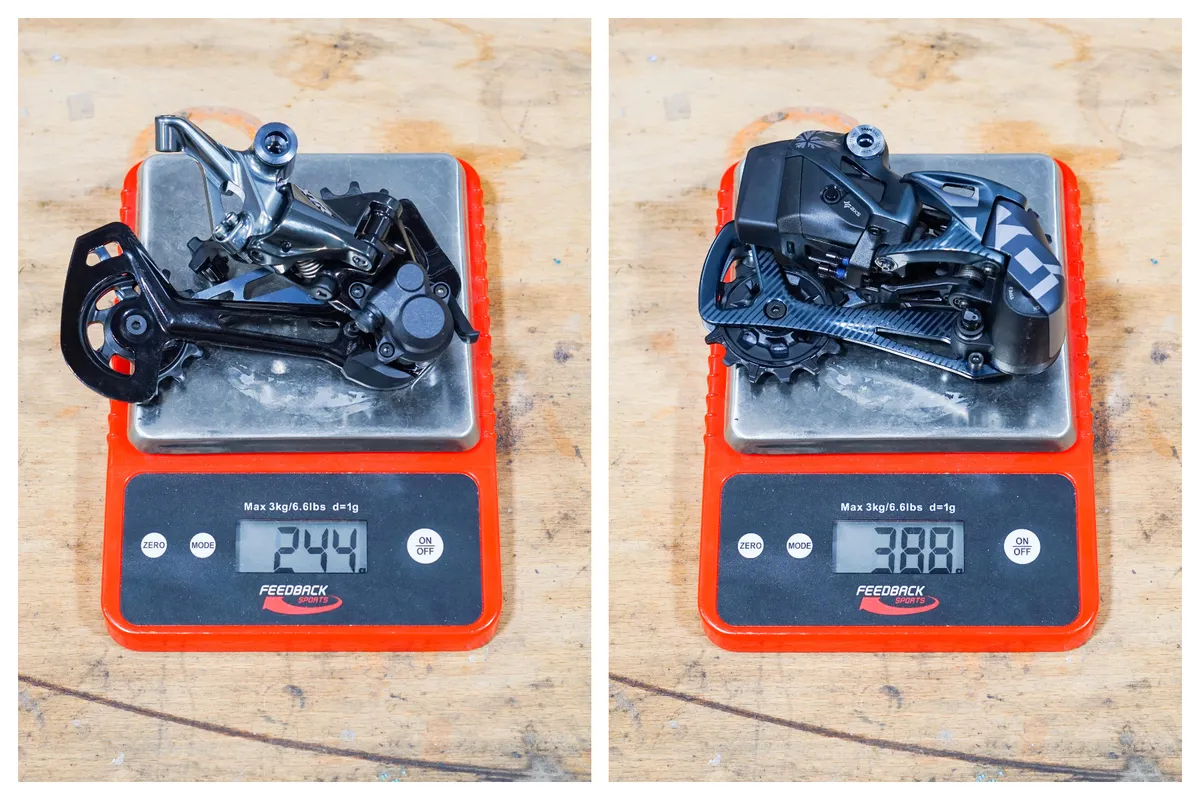
- Shimano: 244g (£189.99 / $259.99)
- SRAM: 388g (£660 / $700)
Shimano XTR M9100 vs SRAM X01 Eagle AXS crankset
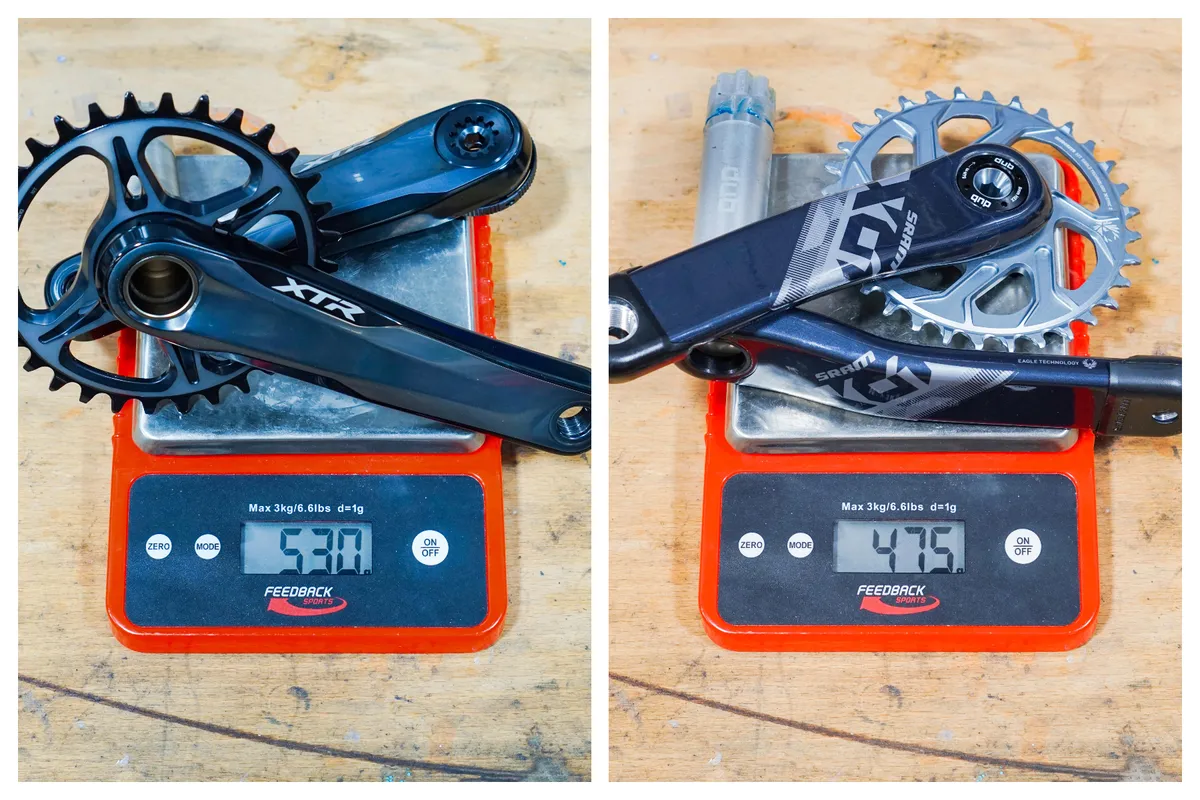
- Shimano: 530g (£309.99 / $419.99)
- SRAM: 475g (£480 / $485)
Shimano XTR M9100 vs SRAM X01 Eagle AXS bottom bracket
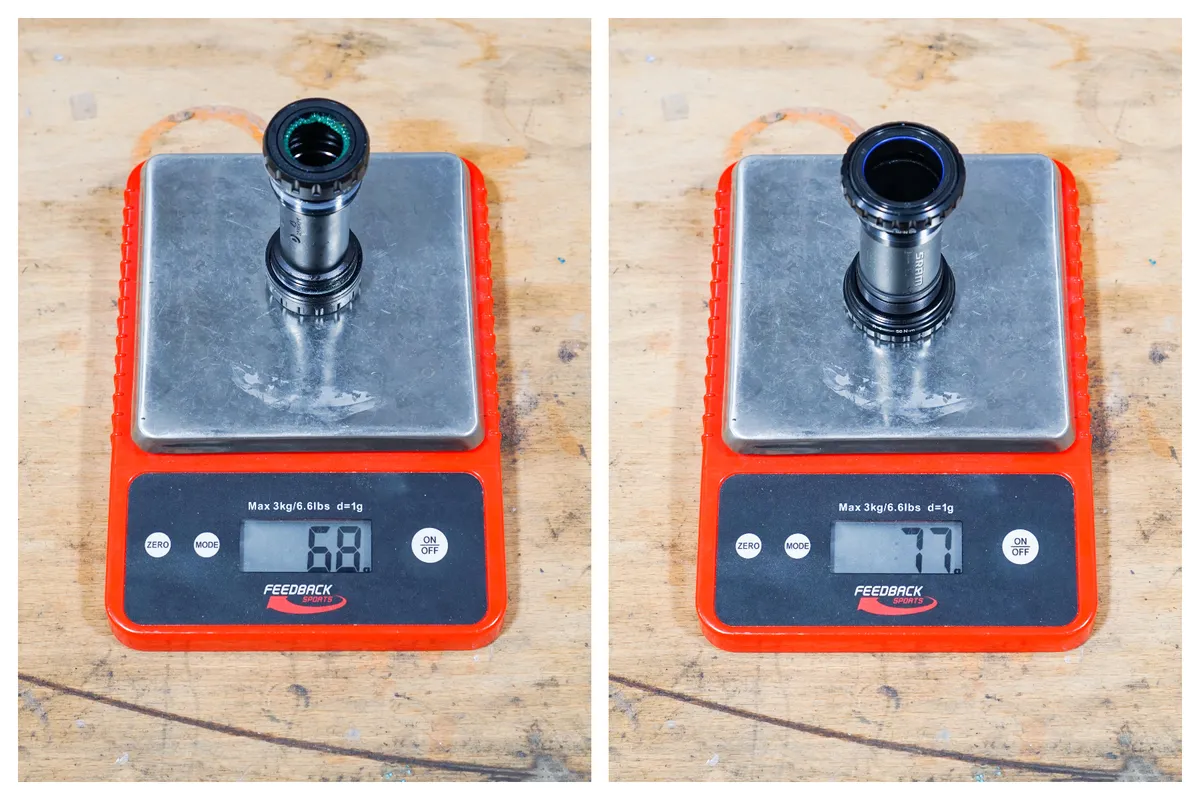
- Shimano: 68g (£47.99 / $40.99)
- SRAM: 77g (£32 / $43)
Shimano XTR M9100 vs SRAM X01 Eagle AXS shifter

- Shimano: 187g (£94.99 /$129.99)
- SRAM: 83g (£200 / $200)
Shimano XTR M9100 vs SRAM X01 Eagle AXS cassette
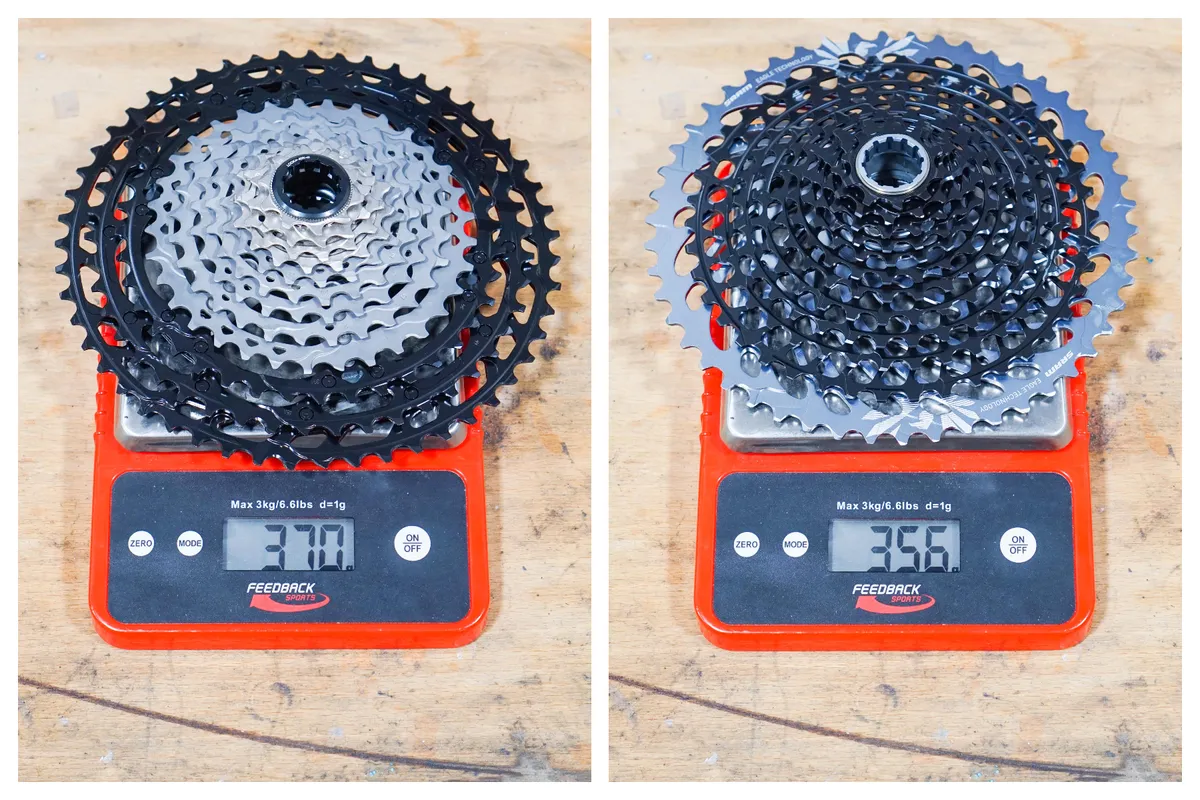
- Shimano: 370g (£289.99 / $397.99)
- SRAM: 356g (£349 / $385)
Shimano XTR M9100 Hyperglide Plus SRAM X01 Eagle AXS chain

- Shimano: 245g (£49.99 / $64.99)
- SRAM: 263g (£58 / $60)
Shimano XTR M9100 vs SRAM X01 Eagle AXS overall
As we said before, this isn’t the weight of the overall groupset, just the components we had that feature in both. It does give you an idea of how they compare.
The SRAM X01 Eagle AXS groupset (derailleur, crankset, bottom bracket, shifter, cassette and chain) totalled 1,642g, while the Shimano XTR M9100 groupset with the same components weighed only 2g more at 1,644g.
A wireless groupset weighing only 2g less than a cable-actuated one is not what we expected. However, when you study the numbers for each component, there are some pretty standout differences that fall in favour for either brand.
For example, the Shimano rear derailleur weighed 144g less than the SRAM, but that is to be expected when you consider that the latter is also carrying the weight of the removable battery, motor, gearbox, Overload Clutch and Roller Bearing Clutch.
At the other end of the spectrum, the Shimano shifter weighed a whopping 104g more than the SRAM, though it's still light for a mechanical shifter, and includes the weight of the inner and outer cable.
The fact that both groupsets pretty much weigh the same just goes to show that wireless shifting saves on cable weight, but comes with the penalty of bringing electronics along for the ride.
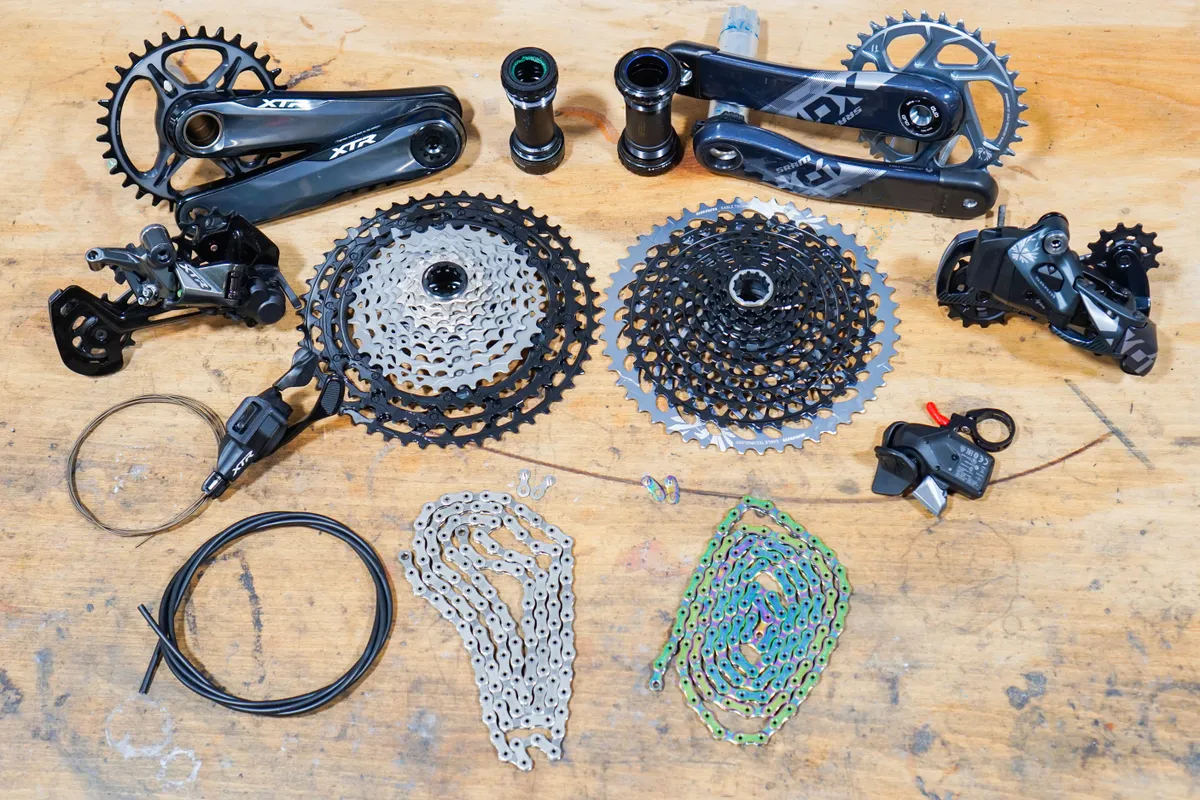
SRAM X01 Eagle AXS vs Shimano XTR M9000: which groupset is best?
So which groupset is best? In truth, it’s a tricky question.
SRAM’s wireless AXS system is fantastic. It’s easy to setup and provides consistent, cable-free and accurate control of your drivetrain with instant, trouble-free shifting.
You can set up the shifter to do as you please, and the dual-clutch design of the mech should reduce some crash anxiety. However, it is pricey should you total the mech off a rock.
Meanwhile, Shimano has nailed the mechanical drivetrain, with a perfect feel through the shifter and across the cassette regardless of how much power you’re pushing through the cranks.
The rear derailleur has an adjustable clutch and is cheaper to replace if it all goes wrong. You also can’t forget to charge it, and it has that marginally wider range.
And, which, then, would I put on my bike?
Truly money no object, it is hard to look past the futuristic SRAM AXS drivetrain, which is at the forefront of drivetrain design. With a healthy budget, I'd go XTR, potentially freeing up extra cash for other top-end components - it's mechanical performance is exceptional, across the board.
With a more 'normal', I’d actually buy the new Shimano SLX drivetrain with an XT shifter, because the XT shifter is pretty much the same as the XTR equivalent (SLX only gets single release shifting).
The SLX cassette, mech and cranks will add weight, but will also save you a packet without genuinely impacting performance on the trails.

